This repo implements a collection of Ethernet-related components in Bluespec SystemVerilog(BSV) for high-performance packet processing on FPGA. Specifically, this repo provides modules for generating and parsing UDP/IP/Ethernet packets. An ARP processing unit with non-blocking cache storing address information is also provided to handle MAC address resolution automatically. Beside building a standard UDP/IP/Ethernet stack, blue-ethernet adds support for RoCE(RDMA over Converged Ethernet): 1) integrate the generation and verification of ICRC(Invariant Cyclic Redundancy) in UDP/IP packet processing; 2) provide modules to handle PFC(Priority Flow Control) to realize the lossless network transmission. And finally interface conversion modules are also provided for packet generator and parser to interact with Xilinx 100G Ethernet Subsystem(CMAC).
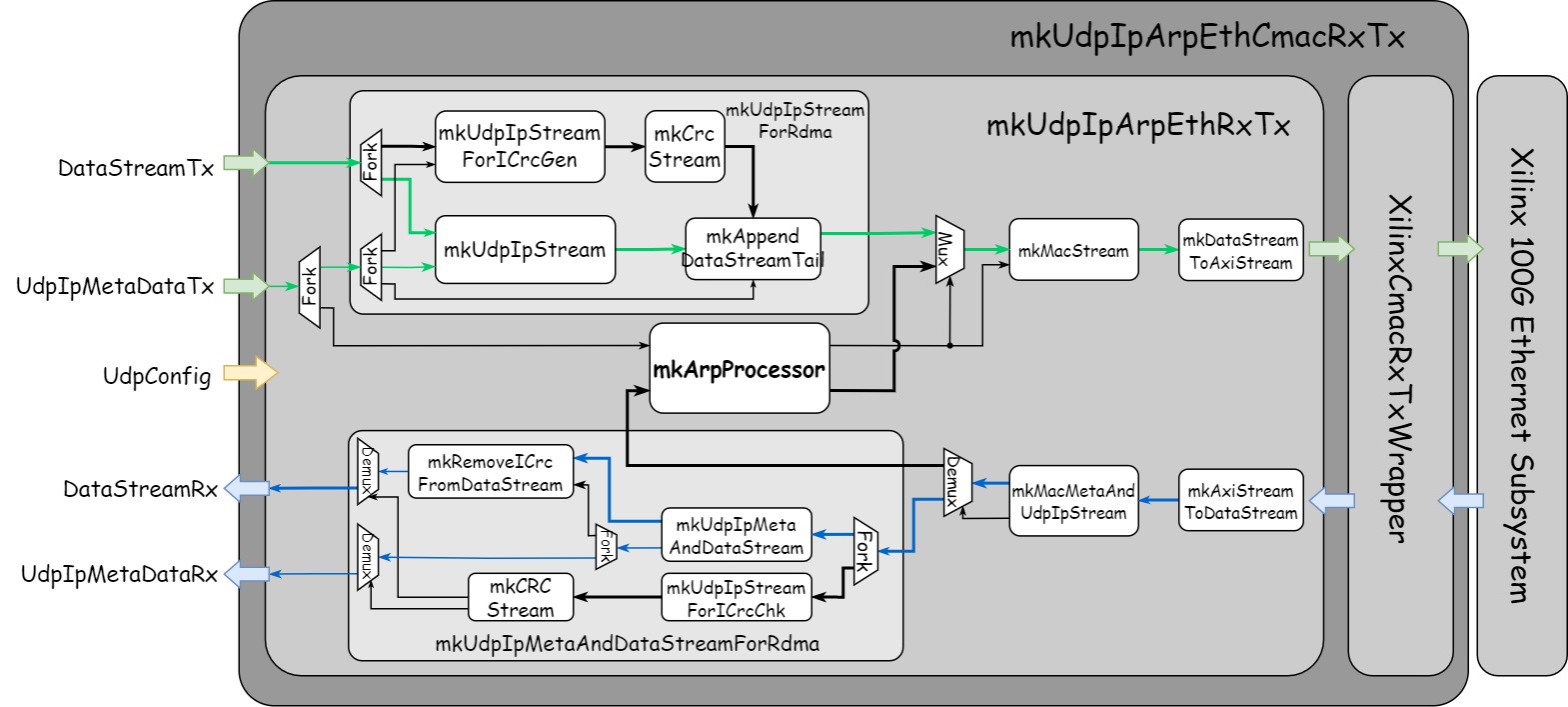
Some key directories of this repo are shown below:
├── lib # external libraries/repos
│ ├── blue-crc # high-performance CRC hardware implementation
│ └── blue-wrapper # BSV wrappers for generating ready-to-use Verilog interface
├── scripts # scripts used to build project
├── src # design source files
│ └── includes # files containing some commonly-used BSV types and modules
├── syn # scripts for vivado synthesis and implementation
└── test # source files for verification
├── bluesim # testbenches based on bluesim
├── cocotb # python testbenches based on cocotb
└── vivado # co-simulation with cmac using vivadoHere is a list of some critical source files:
./src
├── ArpCache.bsv # Cache implementation storing MAC addresses got from ARP
├── ArpProcessor.bsv # processing unit handling ARP requests and responses
├── includes
│ ├── CompletionBuf.bsv
│ ├── ContentAddressMem.bsv
│ ├── EthernetTypes.bsv # numeric and struct types about protocol definition
│ ├── PortConversion.bsv # interface conversion modules used to generate ready-to-use Verilog
│ ├── Ports.bsv # numeric and struct types about in/output ports of modules
│ ├── RFile.bsv
│ ├── StreamHandler.bsv # modules implemented for manipulating data stream
│ └── EthUtils.bsv # utility functions and modules
├── MacLayer.bsv # generator and parser for Ethernet packet
├── PfcUdpIpArpEthRxTx.bsv # generator and parser for UDP/IP/Ethernet packet with PFC
├── PriorityFlowControl.bsv # modules handling PFC
├── UdpIpArpEthRxTx.bsv # generator and parser for UDP/IP/Ethernet packet
├── UdpIpEthRx.bsv # parser for UDP/IP/Ethernet packet
├── UdpIpEthTx.bsv # generator for UDP/IP/Ethernet packet
├── UdpIpLayer.bsv # parser and generator for UDP/IP packet
├── UdpIpLayerForRdma.bsv # parser and generator for UDP/IP packet with support for RoCE
└── XilinxCmacRxTxWrapper.bsv # bridge modules between parser/generator and Xilinx CMACThis section provides detailed descriptions of some important components implemented in blue-ethernet, including their functionality, interface and hardware architecture.
What Ethernet-related hardware components do is basically a series of stream manipulations. The packet generator is responsible for inserting the header stream into the head of payload stream to generate complete packet stream. On the contrary, what the parser does is to extract the header stream and payload stream from packet stream. As for adding the checksum for a packet, the packet stream is passed into CRC calculator and then the output CRC value is appended to the tail of the packet stream.
The hardware entity corresponding to the stream we mention here is actually a group of data signals guarded by the valid-ready control signal pair. The valid signal indicates that the source component wants to transfer data. And the ready indicates that the sink is ready to receive data from source. A transfer between source and sink only happens successfully when both valid and ready are high. If the size of data to be transmitted is larger than the size of one transfer, the data needs to be fragmented and transmitted in a series of transfers.
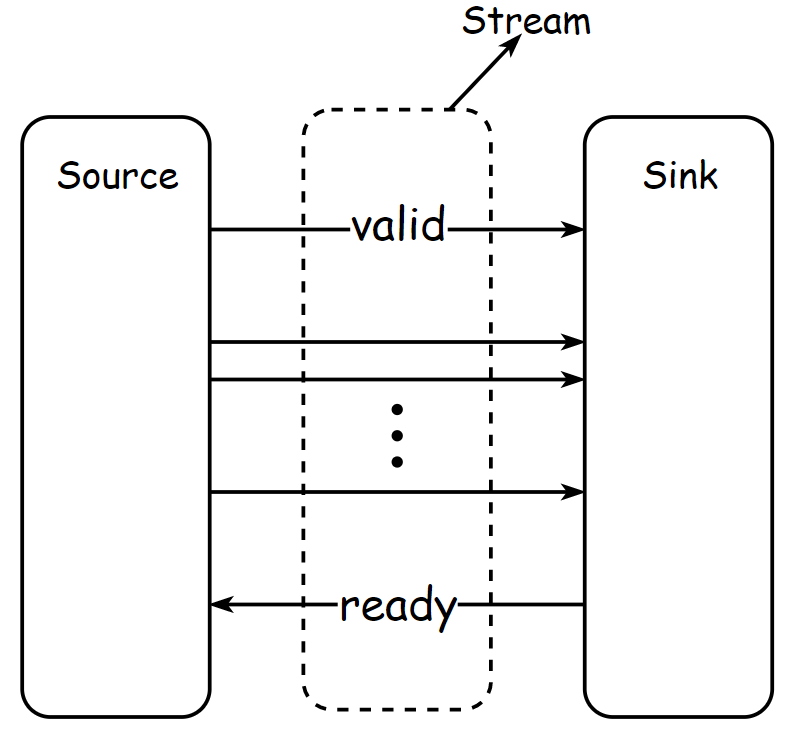
The most tricky and error-prone part of stream processing is about how to handle the valid-ready control signals of different streams. In BSV, the manipulation of control signals is implemented by the compiler and invisible in the grammatical level, which helps designers focus on the logic of stream processing.
Data signals used to transfer packet stream between different components are encapsulated in DataStream struct, which includes 256-bit data signal, 32-bit byte-enable signal, two Boolean signals represents whether this transfer is the last or first of a packet stream.
typedef 256 DATA_BUS_WIDTH;
typedef TDiv#(DATA_BUS_WIDTH, 8) DATA_BUS_BYTE_WIDTH;
typedef Bit#(DATA_BUS_WIDTH) Data;
typedef Bit#(DATA_BUS_BYTE_WIDTH) ByteEn;
typedef struct {
Data data;
ByteEn byteEn;
Bool isFirst;
Bool isLast;
} DataStream deriving(Bits, Bounded, Eq, FShow);module mkAppendDataStreamHead#(
IsSwapEndian swapDataStream,
IsSwapEndian swapAppendData,
FifoOut#(DataStream) dataStreamIn,
FifoOut#(dType) appendDataIn
)(FifoOut#(DataStream));module mkAppendDataStreamTail#(
IsSwapEndian swapDataStream,
IsSwapEndian swapAppendData,
FifoOut#(DataStream) dataStreamIn,
FifoOut#(dType) appendDataIn,
FifoOut#(Bit#(streamLenWidth)) streamLengthIn
)(FifoOut#(DataStream));interface ExtractDataStream#(type dType);
interface FifoOut#(dType) extractDataOut;
interface FifoOut#(DataStream) dataStreamOut;
endinterface
module mkExtractDataStreamHead#(
FifoOut#(DataStream) dataStreamIn
)(ExtractDataStream#(dType));Modules in UdpIpLayer package are implemented for generating and parsing UDP/IP packet.
The packet generator takes in UdpIpMetaData that contains UDP/IP header information and the stream of payload and outputs complete UDP/IP packet stream. The packet parser works in the opposite way by extracting UdpIpMetaData and payload stream from UDP/IP packet stream.
typedef struct {
UdpLength dataLen; # The Length of payload data
IpAddr ipAddr; # Desitnation IP address
IpDscp ipDscp; # DSCP field used for PFC
IpEcn ipEcn; # ECN field
UdpPort dstPort; # Destination port number
UdpPort srcPort; # Source port number
} UdpIpMetaData;Signals encapsulated in UdpIpMetaData struct don’t cover all fields defined in UDP/IP header. Some fields of the header are fixed for a specific network device, which are encapsulated in UdpConfig struct and need to be configured before transmitting or receiving any packets. And some other fields are constant and hard-coded in hardware components.
typedef struct {
EthMacAddr macAddr; # Source MAC address
IpAddr ipAddr; # Source IP address
IpNetMask netMask; # IP netmask
IpGateWay gateWay; # IP gateway
} UdpConfig;module mkUdpIpStream#(
UdpConfig udpConfig,
FifoOut#(DataStream) dataStreamIn,
FifoOut#(UdpIpMetaData) udpIpMetaDataIn,
function UdpIpHeader genHeader(UdpIpMetaData meta, UdpConfig udpConfig, IpID ipId)
)(FifoOut#(DataStream));interface UdpIpMetaDataAndDataStream;
interface FifoOut#(UdpIpMetaData) udpIpMetaDataOut;
interface FifoOut#(DataStream) dataStreamOut;
endinterface
module mkUdpIpMetaDataAndDataStream#(
UdpConfig udpConfig,
FifoOut#(DataStream) udpIpStreamIn,
function UdpIpMetaData extractMetaData(UdpIpHeader hdr)
)(UdpIpMetaDataAndDataStream);Modules in UdpIpLayerForRdma package are implemented based on UdpIpLayer with support for RoCE(RDMA over Converged Ethernet). The additional functionality added to support RoCE is generation and verification of ICRC(Invariant CRC) required for RoCE packets. The format of RoCE packet is defined as below:



Modules in MacLayer package are implemented for generating and parsing Ethernet packet. The generator inserts Ethernet header to the head of UDP/IP packet stream to generate Ethernet packet stream. The parser extracts Ethernet header and UDP/IP packet stream from Ethernet packet stream.
The header information used to generate Ethernet packet is defined in MacMetaData struct.
typedef struct {
EthMacAddr macAddr; # Destination MAC address
EthType ethType; # Type of Ethernet frame
} MacMetaData deriving(Bits, Eq, FShow);To be noted, Ethernet packet handled in the MacLayer only covers fields outlined in the red rectangle in the figure below. Other fields are left to be processed by Xilinx CMAC IP.
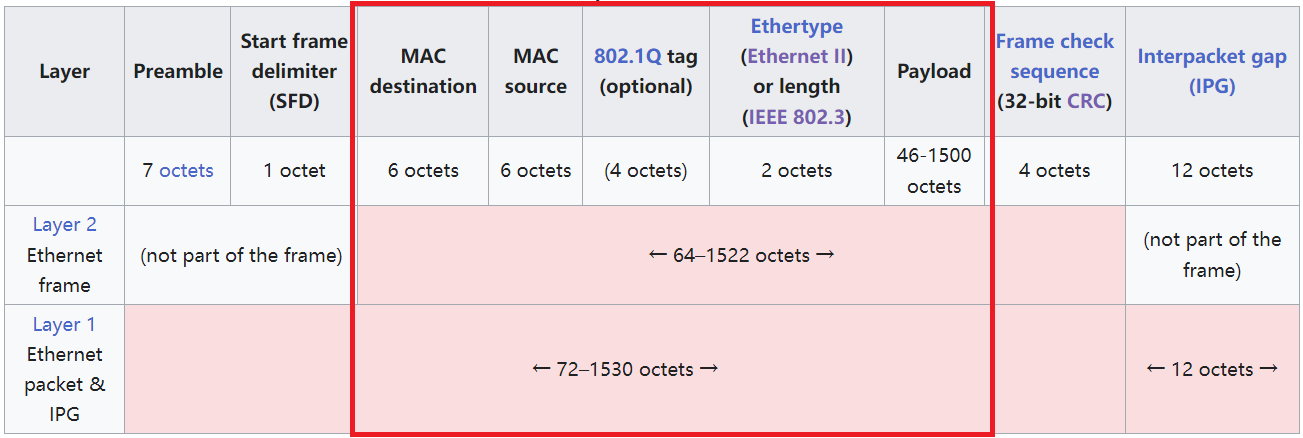
module mkMacStream#(
FifoOut#(DataStream) udpIpStreamIn,
FifoOut#(MacMetaData) macMetaDataIn,
UdpConfig udpConfig
)(FifoOut#(DataStream));interface MacMetaDataAndUdpIpStream;
interface FifoOut#(MacMetaData) macMetaDataOut;
interface FifoOut#(DataStream) udpIpStreamOut;
endinterface
module mkMacMetaDataAndUdpIpStream#(
FifoOut#(DataStream) macStreamIn,
UdpConfig udpConfig
)(MacMetaDataAndUdpIpStream);The Address Resolution Protocol (ARP) is used for discovering MAC address associated with a given IP address. In blue-ethernet, the module mkArpProcessor is implemented for ARP processing, which integrates ARP packet generator, parser and mkArpCache module storing MAC addresses.
For cache used in ARP processing, 32-bit IP address corresponds to cache address and 48-bit MAC address corresponds to cache data. The default arrangement of memory array for ARP cache is shown below, which is 4-way set-associative structure, each way contains 64 lines and each line includes 1-bit valid, 26-bit tag and 48-bit data. The total size of this default array configuration is about 1.2KB. It’s supported to change the size of memory array by setting the number of lines and ways. Based on this memory array, cache is designed to be non-blocking, support outstanding requests(multiple requests on flight) and use pseudo-LRU algorithm for cache line replacement.
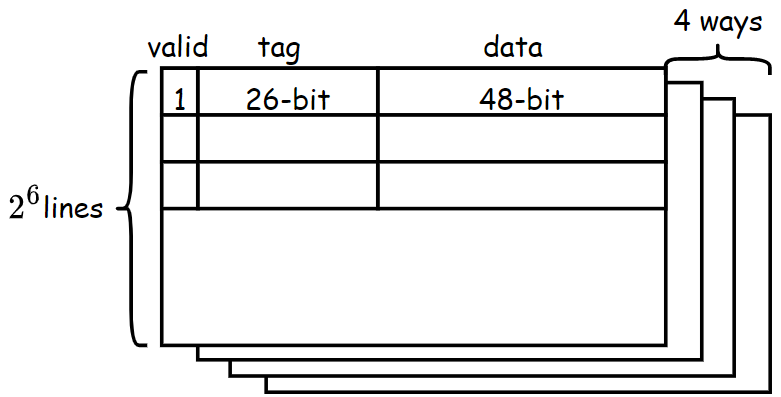
The interface definition and simplified structure diagram of mkArpCache module is shown below. The ArpCache has two subinterfaces: cacheServer handles interactions with components that MAC address resolution service; and arpClient handles interations with mkArpProcessor to initiate ARP request and get MAC address from ARP response. The basic workflow of mkArpCache module is as follows:
When cache receives a read request, it first searches the memory array to get all tags and data corresponding to the given IP address. Then it checks tags to see whether the data we need is stored in the cache. If cache hits, the fetched data is sent to hitBuf. Or the IP address is sent to arpReqBuf to initiate an ARP request. And when the ARP response comes back, the data and address information it carries is both written to cacheWrBuf and missHitBuf to update memory array and return cache read response.
interface ArpCache;
interface Server#(CacheAddr, CacheData) cacheServer;
interface Client#(CacheAddr, ArpResp) arpClient;
endinterface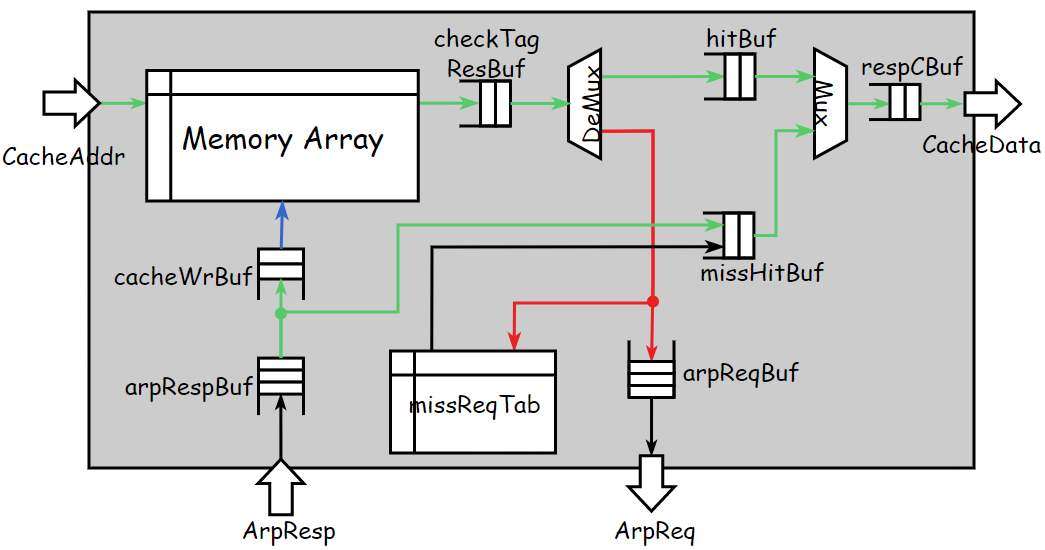
The most difficult part of cache implementation is to support the feature of outstanding, that is supporting multiple read requests on flight. The problem induced by outstanding is that the response time is different for each on-flight ARP request, which means that a late request may receive its response first. So reorder mechanism is needed to guarantee correspondence between request address and response data when cache miss happens. To realize in-order response, the completion buffer respCBuf and content addressable memory missReqTab are integrated in the dataflow. The completion buffer works like FIFO with additional support for the functionality of reservation. Before actual enqueue operation, we can first reserves an order in the completion buffer. And dequeue operation follows the reserved order no matter the actual sequential order of enqueue operations. For each read request, a dequeue order is reversed in respCBuf once it’s received. And because of the ARP request can’t carry the order information, missReqTab is implemented to storing it.
The module can behave as both ARP client and server. As a server, processor needs to generate ARP request if MAC address of target IP is unknown and then waits for ARP response from the target device. As a client, ARP processor receives ARP request from other devices and sends back ARP response carrying its own MAC address.
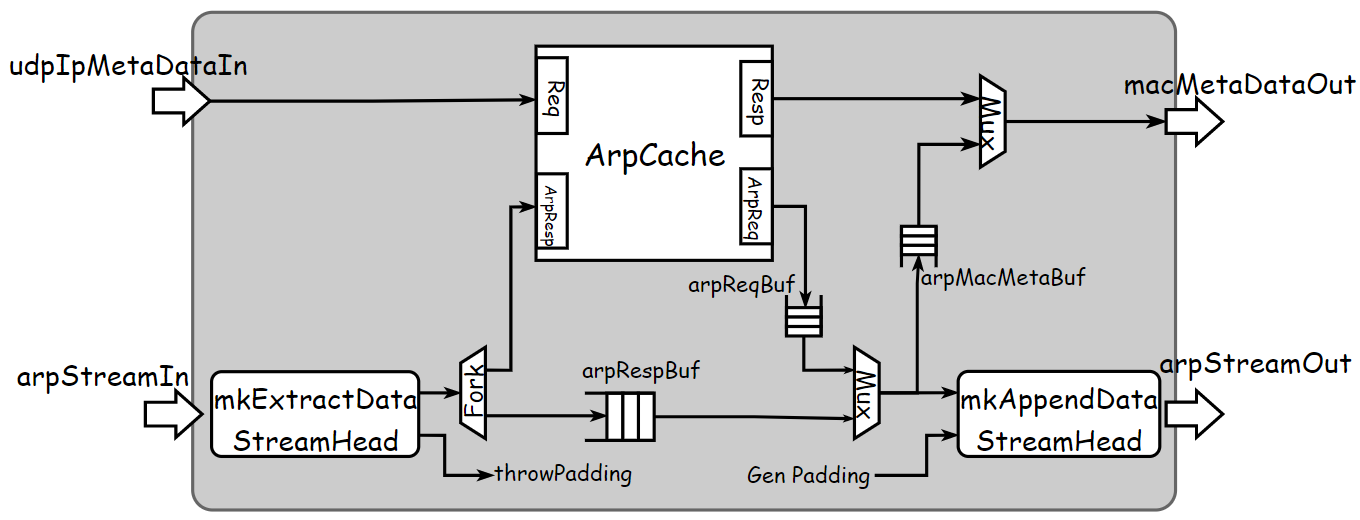
interface ArpProcessor;
interface FifoOut#(DataStream) arpStreamOut;
interface FifoOut#(MacMetaData) macMetaDataOut;
interface Put#(UdpConfig) udpConfig;
endinterface
module mkArpProcessor#(
FifoOut#(DataStream) arpStreamIn,
FifoOut#(UdpIpMetaData) udpIpMetaDataIn
)(ArpProcessor);Modules in UdpIpEthRx package are implemented for receiving and parsing UDP/IP/Ethernet packets.
interface UdpIpEthRx;
interface Put#(UdpConfig) udpConfig;
interface Put#(AxiStream512) axiStreamIn;
interface FifoOut#(MacMetaData) macMetaDataOut;
interface FifoOut#(UdpIpMetaData) udpIpMetaDataOut;
interface FifoOut#(DataStream) dataStreamOut;
endinterface
module mkGenericUdpIpEthRx#(Bool isSupportRdma)(UdpIpEthRx)
Modules in UdpIpEthTx package are implemented for generating and transmitting UDP/IP/Ethernet packets.
interface UdpIpEthTx;
interface Put#(UdpConfig) udpConfig;
interface Put#(UdpIpMetaData) udpIpMetaDataIn;
interface Put#(MacMetaData) macMetaDataIn;
interface Put#(DataStream) dataStreamIn;
interface AxiStream512FifoOut axiStreamOut;
endinterface
module mkGenericUdpIpEthTx#(Bool isSupportRdma)(UdpIpEthTx);
Modules provided in UdpIpArpEthRxTx package is designed to receive and transmit UDP/IP/Ethernet packets and handle ARP request and response at the same time.
The module can be divided into two opposite paths of streams, including transmission path and reception path:
For transmission path, it takes in dataStreamInTx carrying payload stream and udpIpMetaDataIn carrying header information stream and generates axiStreamOutTx carring UDP/IP/Ethernet packet stream. There is no need to provides MacMetaData that contains Ethernet header information as mkUdpIpEthTx module, because mkArpProcessor is responsible for handling MAC address resolution and generating Ethernet header information.
For the reception path, it works in the opposite way by extracting dataStreamOutRx carrying payload stream and udpIpMetaDataOutRx carrying header information stream from axiStreamInRx carrying UDP/IP/Ethernet packet stream.
The Ethernet packet generator and parser are shared by both UDP/IP packet and ARP packet, so additional Mux and Demux are needed in the transmission and reception path for stream arbitration and distribution. The module parameter isSupportRdma specifies whether or not it supports RoCE packet processing. If support for RDMA is disabled, we only need mkUdpIpStream and mkUdpIpMetaAndDataStream in the transmision and reception path respectively.
interface UdpIpArpEthRxTx;
interface Put#(UdpConfig) udpConfig;
// Tx
interface Put#(UdpIpMetaData) udpIpMetaDataInTx;
interface Put#(DataStream) dataStreamInTx;
interface AxiStream512FifoOut axiStreamOutTx;
// Rx
interface Put#(AxiStream512) axiStreamInRx;
interface FifoOut#(UdpIpMetaData) udpIpMetaDataOutRx;
interface FifoOut#(DataStream) dataStreamOutRx;
endinterface
module mkGenericUdpIpArpEthRxTx#(Bool isSupportRdma)(UdpIpArpEthRxTx);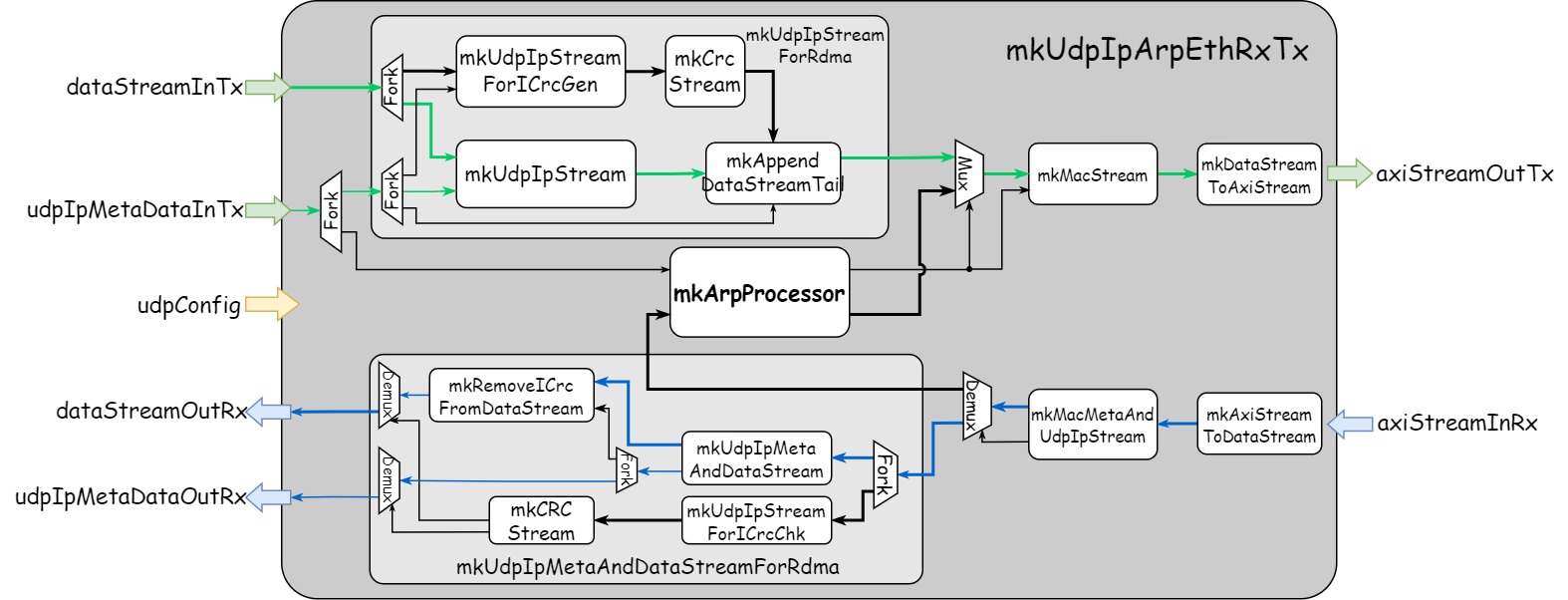
The module wraps mkGenericUdpIpArpEthRxTx using modules provided in blue-wrapper so that it generates ready-to-use Verilog interface.
The module integrates both mkGenericUdpIpArpEthRxTx module and mkXilinxCmacTxWrapper module. It’s designed to interact with Xilinx CMAC IP to transmits and receives UDP/IP/Ethernet packets to and from physical medium.
Modules in PriorityFlowControl package are implemented to realize mechanism of priority flow control to ensure lossless network transmission.
interface PriorityFlowControlTx;
interface Get#(UdpIpMetaData) udpIpMetaDataOut;
interface Get#(DataStream) dataStreamOut;
endinterface
module mkPriorityFlowControlTx#(
FifoOut#(FlowControlReqVec) flowControlReqVecIn,
Vector#(VIRTUAL_CHANNEL_NUM, DataStreamFifoOut) dataStreamInVec,
Vector#(VIRTUAL_CHANNEL_NUM, UdpIpMetaDataFifoOut) udpIpMetaDataInVec
)(PriorityFlowControlTx);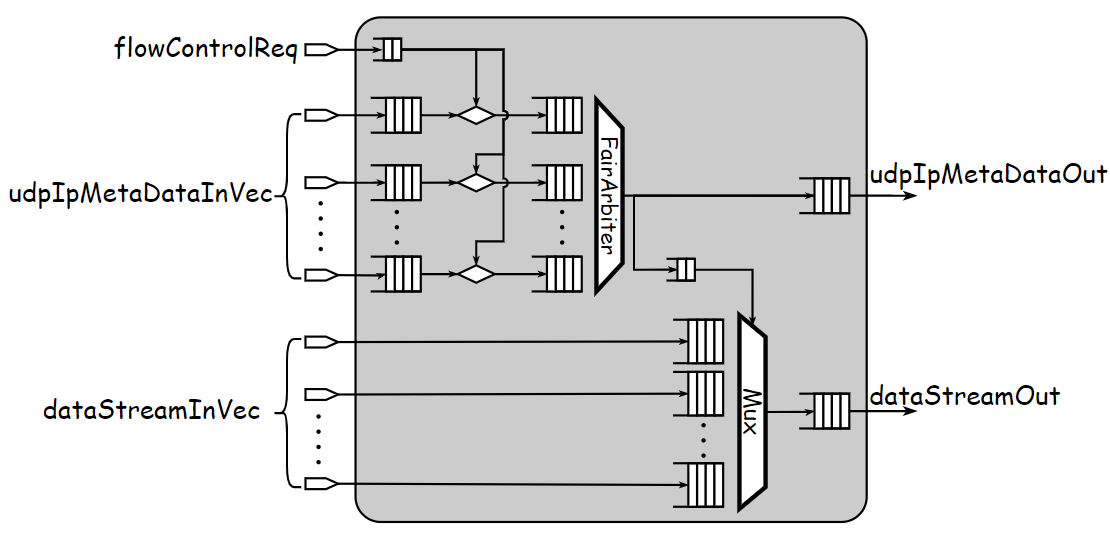
interface PriorityFlowControlRx#(
numeric type bufPacketNum,
numeric type maxPacketFrameNum,
numeric type pfcThreshold
);
interface FifoOut#(FlowControlReqVec) flowControlReqVecOut;
interface Vector#(VIRTUAL_CHANNEL_NUM, Get#(DataStream)) dataStreamOutVec;
interface Vector#(VIRTUAL_CHANNEL_NUM, Get#(UdpIpMetaData)) udpIpMetaDataOutVec;
endinterface
module mkPriorityFlowControlRx#(
DataStreamFifoOut dataStreamIn,
UdpIpMetaDataFifoOut udpIpMetaDataIn
)(PriorityFlowControlRx#(bufPacketNum, maxPacketFrameNum, pfcThreshold));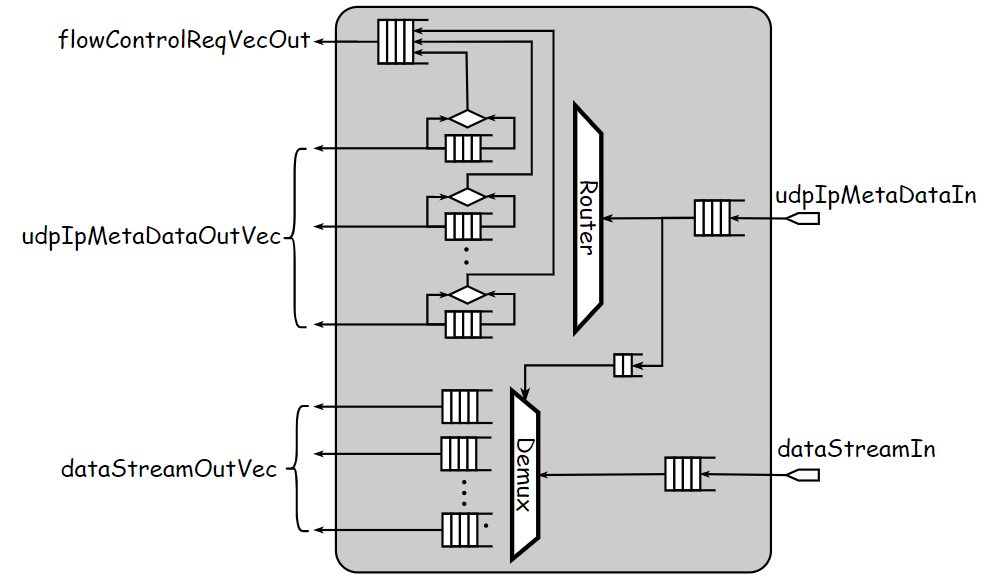
mkGenericPfcUdpIpArpEthRxTx integrates mkPriorityFlowControlRx/Tx and mkGenericUdpIpArpEthRxTx to provide the functionality of generating and parsing UDP/IP/Ethernet packets while supporting priority flow control. For packet transmission, it takes eight channels of payload stream and UDP/IP header information, and outputs one UDP/IP/Ethernet packet stream. For packet reception, it takes in one UDP/IP/Ethernet packet stream and routes the extracted UDP/IP header and payload stream to one of eight output channels.
mkPfcUdpIpArpEthCmacRxTx integrates both mkGenericPfcUdpIpArpEthRxTx module and mkXilinxCmacTxWrapper module. It’s designed to interact with Xilinx CMAC IP to transmits and receives UDP/IP/Ethernet packets to and from physical medium.
The synthesis and implementation of the main module mkGenericUdpIpArpEthRxTx are performed based on Xilinx xcvu9p device using Vivado. And results show that the circuit can reach the working frequency of 500MHz and provide the peak throughput of 128Gbps. The usage of hardware resources is listed as follows:
CLB Logic
+----------------------------+-------+-------+------------+-----------+-------+
| Site Type | Used | Fixed | Prohibited | Available | Util% |
+----------------------------+-------+-------+------------+-----------+-------+
| CLB LUTs | 63886 | 0 | 0 | 1182240 | 5.40 |
| LUT as Logic | 41242 | 0 | 0 | 1182240 | 3.49 |
| LUT as Memory | 22644 | 0 | 0 | 591840 | 3.83 |
| LUT as Distributed RAM | 22644 | 0 | | | |
| LUT as Shift Register | 0 | 0 | | | |
| CLB Registers | 44099 | 0 | 0 | 2364480 | 1.87 |
| Register as Flip Flop | 44099 | 0 | 0 | 2364480 | 1.87 |
| Register as Latch | 0 | 0 | 0 | 2364480 | 0.00 |
| CARRY8 | 73 | 0 | 0 | 147780 | 0.05 |
| F7 Muxes | 194 | 0 | 0 | 591120 | 0.03 |
| F8 Muxes | 28 | 0 | 0 | 295560 | <0.01 |
| F9 Muxes | 0 | 0 | 0 | 147780 | 0.00 |
+----------------------------+-------+-------+------------+-----------+-------+
BLOCKRAM
+-------------------+------+-------+------------+-----------+-------+
| Site Type | Used | Fixed | Prohibited | Available | Util% |
+-------------------+------+-------+------------+-----------+-------+
| Block RAM Tile | 4.5 | 0 | 0 | 2160 | 0.21 |
| RAMB36/FIFO* | 4 | 0 | 0 | 2160 | 0.19 |
| RAMB36E2 only | 4 | | | | |
| RAMB18 | 1 | 0 | 0 | 4320 | 0.02 |
| RAMB18E2 only | 1 | | | | |
| URAM | 0 | 0 | 0 | 960 | 0.00 |
+-------------------+------+-------+------------+-----------+-------+This section introduces how to get started with this project. Before any other steps, you first need to set up development environment referring to the script setup.sh. Here is a list of dependencies:
After setting up the environment, clone this repo to a specific directory. Here we refer to this directory as BLUE_ETH:
git clone --recursive https://github.com/wengwz/blue-ethernet.git $(BLUE_ETH)There are three different levels of testbenches provided in blue-ethernet:
# Specify TARGET to the name of target component
cd $(BLUE_ETH)/test/bluesim
make TARGET=ArpCache# Run tests of UdpIpEthRx/Tx
# Enable/Disable support for RDMA by setting SUPPORT_RDAM to True/False
cd $(BLUE_ETH)/test/cocotb
make cocotb TARGET=UdpIpEthTx SUPPORT_RDMA=TRUE
# Run simulation on virtual network
# Change NET_IFC in run_docker_net_test.sh to the name of your network card
cd $(BLUE_ETH)/test/cocotb
docker build -f ./build_docker/Dockerfile -t ethernet-test ./build_docker
./run_docker_net_test.sh# Available TARGET includes UdpIpArpEthCmacRxTx/PfcUdpIpArpEthCmacRxTx
# Enable/Disable support for RDMA by setting SUPPORT_RDAM to True/False
cd $(BLUE_ETH)/test/vivado
make sim TARGET=UdpIpArpEthCmacRxTx SUPPORT_RDMA=FalseScripts used to run synthesis and implementation of designs are provided in the directory $(BLUE_ETH)/syn.
# TARGET specifies the top module to be synthsized or implemented
# SUPPORT_RDMA specifies whether modules supports RoCE packet processing
# ONLYSYNTH decides whether or not run implemetation after synthesis
cd $(BLUE_ETH)/syn
make vivado TARGET=UdpIpArpEthRxTx SUPPORT_RDMA=False ONLYSYNTH=0# TARGET specifies the name of top module to be generated
# Specify SUPPORT_RDMA if needed
cd $(BLUE_ETH)/test/cocotb
make verilog TARGET=UdpIpEthTx SUPPORT_RDMA=TRUEbsc -p +:$(BLUE_ETH)/src:$(BLUE_ETH)/src/includes ...The implementation of blue-ethernet involves the usage of following external libraries: